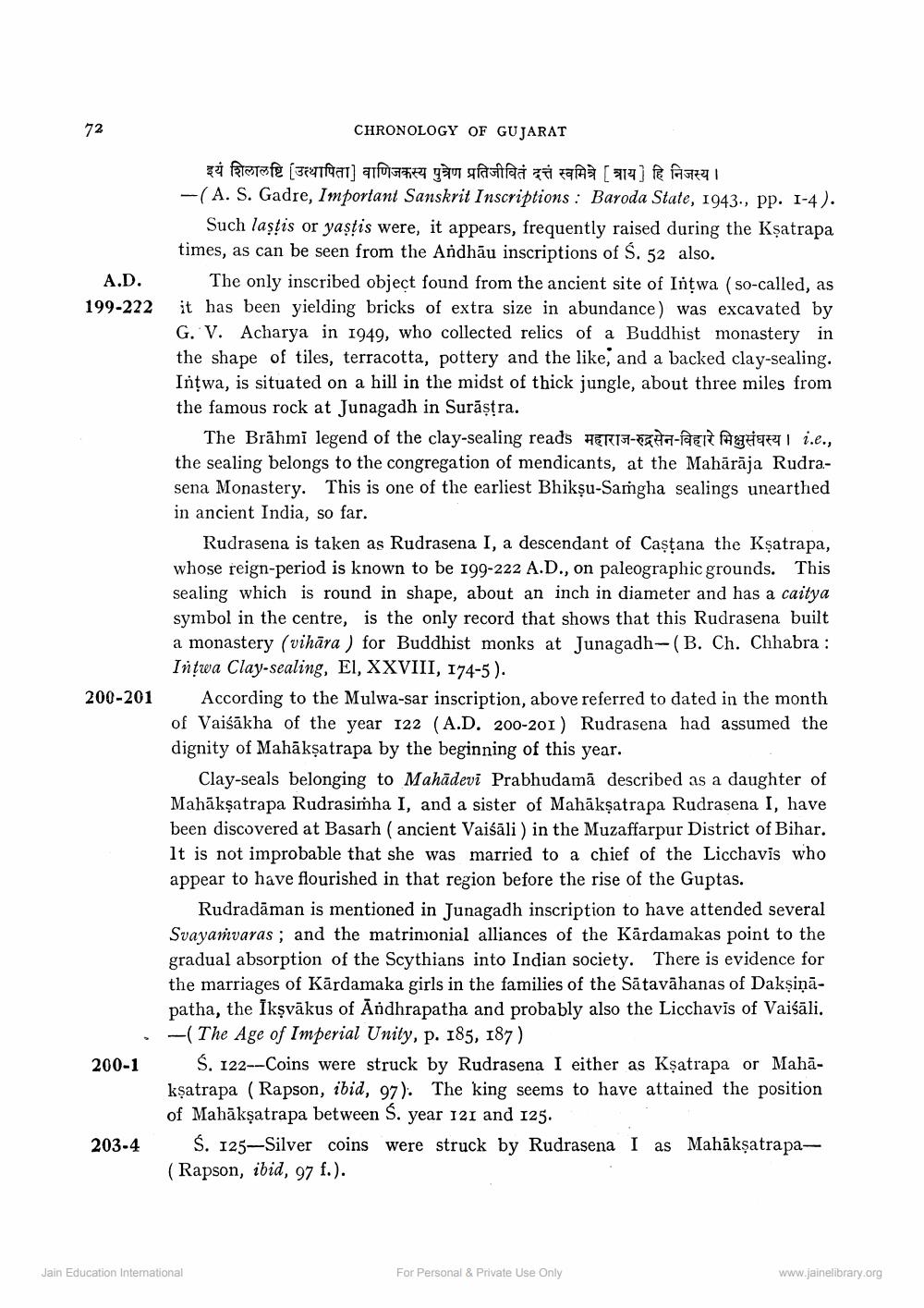________________
A.D. 199-222
CHRONOLOGY OF GUJARAT इयं शिलालष्टि [उत्थापिता] वाणिजकस्य पुत्रेण प्रतिजीवितं दत्तं स्वमित्रे [त्राय) हि निजस्य । -(A. S. Gadre, Important Sanskrit Inscriptions : Baroda State, 1943., pp. 1-4).
Such laştis or yastis were, it appears, frequently raised during the Kșatrapa times, as can be seen from the Andhāu inscriptions of S. 52 also.
The only inscribed object found from the ancient site of Inţwa (so-called, as it has been yielding bricks of extra size in abundance) was excavated by G. V. Acharya in 1949, who collected relics of a Buddhist monastery in the shape of tiles, terracotta, pottery and the like, and a backed clay-sealing. Inţwa, is situated on a hill in the midst of thick jungle, about three miles from the famous rock at Junagadh in Surāṣtra.
The Brāhmi legend of the clay-sealing reads HERIF-EN-ERFAHTI i.e., the sealing belongs to the congregation of mendicants, at the Mahārāja Rudrasena Monastery. This is one of the earliest Bhikṣu-Samgha sealings unearthed in ancient India, so far.
Rudrasena is taken as Rudrasena I, a descendant of Castana the Kșatrapa, whose reign-period is known to be 199-222 A.D., on paleographic grounds. This sealing which is round in shape, about an inch in diameter and has a caitya symbol in the centre, is the only record that shows that this Rudrasena built a monastery (vihāra ) for Buddhist monks at Junagadh-(B. Ch. Chhabra : Intwa Clay-sealing, EI, XXVIII, 174-5).
According to the Mulwa-sar inscription, above referred to dated in the month of Vaišākha of the year 122 (A.D. 200-201) Rudrasena had assumed the dignity of Mahākṣatrapa by the beginning of this year.
Clay-seals belonging to Mahādevi Prabhudamā described as a daughter of Mahākṣatrapa Rudrasimha I, and a sister of Mahākşatrapa Rudrasena I, have been discovered at Basarh ( ancient Vaiśāli) in the Muzaffarpur District of Bihar. It is not improbable that she was married to a chief of the Licchavis who appear to have flourished in that region before the rise of the Guptas.
Rudradāman is mentioned in Junagadh inscription to have attended several Svayamvaras; and the matrimonial alliances of the Kārdamakas point to the gradual absorption of the Scythians into Indian society. There is evidence for the marriages of Kārdamaka girls in the families of the Sātavāhanas of Dakşiņāpatha, the Ikşvākus of Andhrapatha and probably also the Licchavis of Vaiśāli. - The Age of Imperial Unity, p. 185, 187)
S. 122--Coins were struck by Rudrasena I either as Ksatrapa or Mahākşatrapa (Rapson, ibid, 97). The king seems to have attained the position of Mahākṣatrapa between S. year 121 and 125.
Ś. 125-Silver coins were struck by Rudrasena I as Mahākṣatrapa(Rapson, ibid, 97 f.).
200-201
. 200-1
203-4
Jain Education Intemational
For Personal & Private Use Only
www.jainelibrary.org




